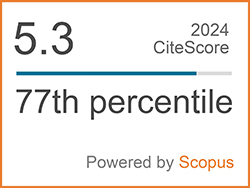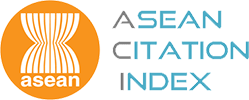Phytochemical Profiling, Antioxidant, and Antityrosinase Activities of Bamboo Leaves in Thailand
Abstract
Keywords
[1] C. Nirmala, M. S. Bisht, H. K. Bajwa, and O. Santosh, “Bamboo: A rich source of natural antioxidants and its applications in the food and pharmaceutical industry,” Trends in Food Science & Technology, vol. 77, pp. 91–99, 2018.
[2] J. Gagliano, F. Moreira, W. Carvalho, and C. M. Furlan, “What is known about the medicinal potential of bamboo?,” Advances in Traditional Medicine, 2021, doi: 10.1007/ s13596-020-00536-5.
[3] I. Kimura, S. Kagawa, H. Tsuneki, K. Tanaka, and F. Nagashima, “Multitasking bamboo leafderived compounds in prevention of infectious, inflammatory, atherosclerotic, metabolic, and neuropsychiatric diseases,” Pharmacology and Therapeutics, vol. 235, 2022, Art. no. 108159.
[4] A. Ilham, S. Vimala, A. Rashih, R. Sahdan, M. Jamaluddin, and M. Juliza, “Antioxidant and antityrosinase properties of Malaysian bamboo leaf extracts,” Journal of Tropical Forest Science, vol. 20, pp. 123–131, 2018.
[5] N. Saewan, S. Koysomboon, and K. Chantrapromma, “Anti-tyrosinase and anti-cancer activities of flavonoids from Blumea balsamifera DC,” Journal of Medicinal Plants Research, vol. 5, pp. 1018–1025, 2010.
[6] S. Tewari, M. Patel, A. V. F. Debnath, P. Mehta, S. Patel, and S. Bakshi, “Bamboo leaf extract ameliorates radiation induced genotoxicity: An in vitro study of chromosome aberration assay,” Journal of Herbal Medicine, vol. 31, 2022, Art. no. 100528.
[7] G. Cao, Y. Yu, H. Wang, J. Liu, X. Zhang, Y. Yu, Z. Li, Y. Zhang, and C. Yang, “Effects of oral administration of bamboo (Dendrocalamus membranaceus) leaf flavonoids on the antioxidant capacity, caecal microbiota, and serum metabolome of Gallus gallus domesticus,” Frontiers in Nutrition, vol. 9, pp. 1–16, 2022.
[8] Y. Gu, F. Xue, H. Xiao, L. Chen, and Y. Zhang, “Bamboo leaf flavonoids suppress oxidative stress-induced senescence of HaCaT cells and UVB-induced photoaging of mice through p38 MAPK and autophagy signaling,” Nutrients, vol. 14, no. 4, 2022, Art. no. 793.
[9] X. Li, W. Tao, H. Xun, X. Yao, J. Wang, J. Sun, Y. Yue, and F. Tang, “Simultaneous determination of flavonoids from bamboo leaf extracts using liquid chromatography-tandem mass spectrometry,” Revista Brasileira de Farmacognosia, vol. 31, no. 3, pp. 347–352, 2021.
[10] C. J. Hu, D. H. Xu, H. L. Chen, and K. Yuan, “Contents of the total flavonoids and the total phenols and antioxidant activities in the leaf from different species of Phyllostachys,” Advanced Materials Research, vol. 343–344, pp. 1103–1108, 2012.
[11] J. Wang, Y. D. Yue, F. Tang, and J. Sun, “TLC screening for antioxidant activity of extracts from fifteen bamboo species and identification of antioxidant flavone glycosides from leaves of Bambusa textilis McClure,” Molecules, vol. 17, no. 10, pp. 12297–12311, 2012.
[12] Q. Ni, Y. Zhang, G. Xu, Q. Gao, L. Gong, and Y. Zhang, “Influence of harvest season and drying method on the antioxidant activity and active compounds of two bamboo grass leaves,” Journal of Food Processing and Preservation, vol. 38, no. 4, pp. 1565–1576, 2014.
[13] P. Karawak, S. Sengsai, C. Thepsithar, and S. Maksup, “Phytochemical content and antioxidant activity of leaf extracts from nine bamboo species and determination of flavone C-glycosides by TLC and HPLC,” International Society for Horticultural Science (ISHS), vol. 1298, pp. 359–370, 2020.
[14] M. Das, S. Bhattacharya, P. Singh, T. S. Filgueiras, and A. Pal, “Bamboo taxonomy and diversity in the era of molecular markers,” Advances in Botanical Research, vol. 47, pp. 225–268, 2008.
[15] S. Sungkaew, A. Teerawattananon, and K. Jindawong, Bamboo of Thailand. Bangkok, Thailand: Baanlaesuan press, 2011.
[16] M.-H. Liu, C.-H. Ko, N. Ma, P.-W. Tan, W.-M. Fu, and J.-Y. He, “Chemical profiles, antioxidant and anti-obesity effects of extract of Bambusa textilis McClure leaves,” Journal of Functional Foods, vol. 22, pp. 533–546, 2016.
[17] Y.-C. Jin, H.-L. Liu, and K. Yuan, “Simultaneous determination of seven effective constituents in the leaves of bamboo by reversed phase high performance liquid chromatography (RP-HPLC),” Journal of Medicinal Plant Research, vol. 5, pp. 5630–5635, 2011.
[18] G. Pizzino, N. Irrera, M. Cucinotta, G. Pallio, F. Mannino, V. Arcoraci, F. Squadrito, D. Altavilla, A. Bitto, “Oxidative stress: Harms and benefits for human health,” Oxidative Medicine and Cellular Longevity, vol. 2017, pp. 8416763– 8416763, 2017.
[19] J. Panee, “Potential medicinal application and toxicity evaluation of extracts from bamboo plants,” Journal of Medicinal Plant Research, vol. 9, no. 23, pp. 681–692, 2015.
[20] R. Pujiarti, S. Suryani, S. Sunarta, G. Lukmandaru, and B. Purba, “Extractive contents and DPPHscavenging activities of bamboo leaf extracts from Gigantochloa atter, Dendrocalamus asper, and Gigantochloa verticillata,” Taiwan Journal of Forest Science, vol. 35, pp. 1–12, 2020.
[21] N.-H. Ma, J. Guo, S.-H. Chen, X.-R. Yuan, T. Zhang, and Y. Ding, “Antioxidant and compositional HPLC Analysis of three common bamboo leaves,” Molecules, vol. 25, 2020, Art. no. 409.
[22] M. Huh, M. Han, C. Park, and Y. Choi, “Inhibitory effects of Phyllostachys bambusoides on melanin synthesis and tyrosinase activity in cultured human melanoma cells,” Journal of Life Science, vol. 24, pp. 284–289, 2014.
[23] M.-H. Choi, H.-G. Jo, J. H. Yang, S. H. Ki, and H.-J. Shin, “Antioxidative and anti-melanogenic activities of bamboo stems (Phyllostachys nigra variety henosis) via PKA/CREB-mediated MITF downregulation in B16F10 melanoma cells,” Journal of Life Science, vol. 19, no. 2, 2018, Art. no. 409.
[24] W. Qian, W. Liu, D. Zhu, Y. Cao, A. Tang, G. Gong, and H. Su, “Natural skin‑whitening compounds for the treatment of melanogenesis (Review),” Experimental and Therapeutic Medicine, vol. 20, no. 1, pp. 173–185, 2020.
[25] J. Wang, F. Tang, Y. Yue, X. Guo, and X. Yao, “Development and validation of an HPTLC method for simultaneous quantitation of isoorientin, isovitexin, orientin, and vitexin in bamboo-leaf flavonoids,” Journal of AOAC International, vol. 93, pp. 1376–1383, 2010.
[26] J. Gong, J. Huang, G. Xiao, F. Chen, B. Lee, Q. Ge, Y. You, S. Liu, and Y. Zhang, “Antioxidant capacities of fractions of bamboo shaving extract and their antioxidant components,” Molecules, vol. 21, no. 8, 2016, Art. no. 996.
[27] H. Alhaithloul, F. Galal, and A. Seufi, “Effect of extreme temperature changes on phenolic, flavonoid contents and antioxidant activity of tomato seedlings (Solanum lycopersicum L.),” PeerJ, vol. 9, 2021, Art. no. e11193.
[28] M. Ilyas, W. A. Khan, T. Ali, N. Ahmad, Z. Khan, H. Fazal, N. Zaman, D. Ualiyeva, M. Ali, O.B . Amissah, and M. Rizwan, “Cold stressinduced seed germination and biosynthesis of polyphenolics content in medicinally important Brassica rapa,” Phytomedicine Plus, vol. 2, no. 1, 2022, Art. no. 100185.
[29] T. He, L. Fan, M. Tarin, S. Shen, D. Xie, C. Liguang, J. Rong, L. Chen, and Y. Zheng, “Physiological and proteomic responses of Dendrocalamus minor var. amoenus (ghost bamboo) under drought stress,” Applied Ecology and Environmental Research, vol. 18, pp. 4817– 4838, 2020.
[30] S. Biswas, A. Sarkar, E. Kharlyngdoh, B. G. Somkuwar, P. Biswas, S. Dutta, S. Guha, and M. Das, “Evidence of stress induced flowering in bamboo and comments on probable biochemical and molecular factors,” Journal of Plant Biochemistry and Biotechnology, vol. 30, no. 4, pp. 1020–1026, 2021.
DOI: 10.14416/j.asep.2022.09.002
Refbacks
- There are currently no refbacks.
 Applied Science and Engineering Progress
Applied Science and Engineering Progress







